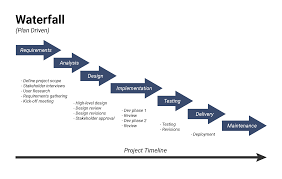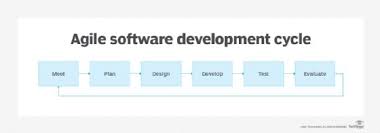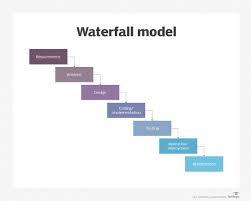The Manifesto for Agile Software Development, commonly known as the Agile Manifesto, is a set of guiding values and principles for software development that have revolutionized the industry. The manifesto was created in 2001 by a group of software developers who were frustrated with the traditional, rigid approach to software development.
The Agile Manifesto emphasizes collaboration, flexibility, and customer satisfaction. It values individuals and interactions over processes and tools, working software over comprehensive documentation, customer collaboration over contract negotiation, and responding to change over following a plan.
One of the key principles of the Agile Manifesto is that software development should be iterative and incremental. Instead of trying to plan out every detail of a project before beginning work, agile teams work in short iterations or sprints. This allows them to quickly adapt to changing requirements or feedback from customers.
Another important principle is that agile teams should prioritize delivering working software that meets the customer’s needs. This means that they focus on creating value for the customer rather than getting bogged down in bureaucracy or unnecessary documentation.
The Agile Manifesto also encourages continuous improvement through regular retrospectives. After each iteration or sprint, the team reflects on what went well and what didn’t go so well. They then make adjustments to their process so that they can improve in future iterations.
Since its creation in 2001, the Agile Manifesto has become widely adopted across industries beyond just software development. Its principles have been applied to everything from marketing campaigns to HR processes.
Overall, the Agile Manifesto has had a profound impact on how software is developed today. It has helped teams become more collaborative, flexible and responsive to change while delivering value to their customers more efficiently than ever before.
9 Essential Tips for Embracing Agile Software Development Manifesto
- Embrace change
- Focus on customer satisfaction
- Prioritize collaboration
- Foster self-organization
- Promote sustainable development
- Measure progress with working software
- Emphasize technical excellence
- Maximize efficiency with automation
- Utilize iterative delivery cycles
Embrace change
One of the key tips for agile software development is to embrace change. In traditional software development methodologies, change is often seen as a negative thing that should be avoided at all costs. However, in agile software development, change is expected and even welcomed.
The Agile Manifesto values responding to change over following a plan. This means that agile teams are prepared to adapt to changing requirements or feedback from customers at any point in the development process. They understand that change is inevitable and that trying to resist it will only lead to frustration and delays.
By embracing change, agile teams are able to create software that truly meets the needs of their customers. They are constantly seeking feedback and looking for ways to improve their product based on that feedback. This leads to a more collaborative relationship between the team and the customer, which ultimately results in better outcomes for everyone involved.
Embracing change also allows agile teams to work more efficiently. Instead of spending time creating detailed plans or documentation up front, they can focus on delivering working software quickly and then iterating based on feedback. This means they can respond more quickly to changing requirements or new information without getting bogged down in bureaucracy.
Overall, embracing change is an important tip for anyone practicing agile software development. It allows teams to be more responsive, collaborative, and efficient while creating software that truly meets the needs of their customers.
Focus on customer satisfaction
One of the key principles of the Manifesto for Agile Software Development is to focus on customer satisfaction. This means that agile teams prioritize delivering working software that meets the needs of their customers.
By focusing on customer satisfaction, agile teams are able to create value for their customers and build long-lasting relationships. They work closely with their customers to understand their needs and requirements, and then use that information to guide their development process.
This approach allows agile teams to quickly respond to changing customer needs and feedback. By delivering working software early and often, they are able to get feedback from customers and make adjustments as needed. This helps ensure that the final product meets the customer’s expectations.
In addition to delivering a product that meets the customer’s needs, focusing on customer satisfaction also helps build trust between the team and the customer. When customers feel heard and valued, they are more likely to continue doing business with that team in the future.
Overall, focusing on customer satisfaction is a key principle of agile software development. By prioritizing customer needs and working closely with them throughout the development process, agile teams are able to deliver high-quality products that meet or exceed their customers’ expectations.
Prioritize collaboration
One of the key tips from the Manifesto for Agile Software Development is to prioritize collaboration. This means that team members should work together closely throughout the development process, rather than working in silos or separately.
Collaboration is essential to agile software development because it helps ensure that everyone is working toward the same goals. When team members collaborate, they can share ideas and expertise, identify and solve problems more quickly, and build a sense of shared ownership over the project.
To prioritize collaboration in agile software development, teams should make sure that everyone has a clear understanding of their roles and responsibilities. They should also establish regular communication channels, such as daily stand-up meetings or weekly check-ins.
Another way to encourage collaboration is to create a culture of transparency and trust. This means being open about challenges or roadblocks, sharing progress updates regularly, and encouraging constructive feedback from all team members.
Ultimately, prioritizing collaboration is about recognizing that software development is a team effort. By working together closely throughout the development process, teams can create better products more efficiently while building stronger relationships with each other.
Foster self-organization
One of the key principles of the Manifesto for Agile Software Development is to foster self-organization. This means that teams are encouraged to take ownership and responsibility for their work, rather than relying on a manager or leader to direct them at every step.
Self-organization empowers team members to make decisions and take action based on their own expertise and knowledge. It allows for more flexibility and adaptability, as team members can quickly respond to changes or challenges without needing approval from a higher-up.
In order to foster self-organization, it’s important for teams to have clear goals and objectives. This gives everyone a shared understanding of what they’re working towards, which helps them make decisions that align with those goals.
It’s also important for teams to have open communication channels. This allows everyone to share ideas, ask questions, and provide feedback in a constructive way. When everyone feels comfortable speaking up and contributing their ideas, it helps create a culture of trust and collaboration.
Finally, it’s important for teams to have the right tools and resources at their disposal. This includes access to the necessary software, hardware, and training needed to do their jobs effectively. When team members feel supported by their organization, they’re more likely to take ownership of their work and strive for excellence.
Overall, fostering self-organization is essential for agile software development teams. It empowers team members to make decisions based on their own expertise while creating a culture of trust and collaboration. By providing clear goals, open communication channels, and the right tools and resources, teams can work together effectively while delivering high-quality results.
Promote sustainable development
One of the key principles of the Manifesto for Agile Software Development is to promote sustainable development. This means that agile teams should be able to maintain a steady pace of work over time, without burning out or sacrificing quality.
In order to promote sustainable development, agile teams should prioritize the well-being of their team members. This includes things like ensuring that team members have a reasonable workload, providing opportunities for professional development, and encouraging a healthy work-life balance.
Agile teams should also focus on creating high-quality software that is easy to maintain over time. This means taking the time to write clean, well-documented code and regularly refactoring existing code to keep it up-to-date.
By promoting sustainable development, agile teams can not only improve their own well-being but also create better software for their customers. By focusing on quality and maintainability, they can ensure that their software continues to meet the needs of their customers over time.
Overall, promoting sustainable development is an important part of the Agile Manifesto. By prioritizing the well-being of team members and creating high-quality software, agile teams can achieve long-term success while delivering value to their customers.
Measure progress with working software
One of the key principles of the Agile Manifesto is to measure progress with working software. This means that instead of relying on documentation or other metrics to track progress, agile teams focus on delivering software that actually works.
This principle is important because it ensures that the team is actually making tangible progress towards their goals. It’s easy to get bogged down in meetings, planning sessions, and other activities that don’t actually result in anything concrete. By focusing on working software, agile teams can ensure that they are delivering value to their customers and stakeholders.
Measuring progress with working software also allows for more frequent feedback loops. Instead of waiting until the end of a project to see if everything works as intended, agile teams can get feedback on each iteration or sprint. This allows them to make adjustments and improvements along the way, rather than waiting until it’s too late.
Another benefit of measuring progress with working software is that it helps keep the team focused on what really matters. It’s easy to get distracted by things like documentation or process improvements, but at the end of the day, what really matters is delivering software that meets the customer’s needs.
Overall, measuring progress with working software is a key principle of agile development. It helps ensure that teams are making tangible progress towards their goals while keeping them focused on delivering value to their customers and stakeholders.
Emphasize technical excellence
One of the key tips outlined in the Agile Manifesto is to emphasize technical excellence. This means that agile teams should focus on creating high-quality software that is maintainable, scalable and reliable.
Technical excellence is crucial to the success of an agile project because it ensures that the software can be delivered quickly and efficiently while still meeting the customer’s needs. By prioritizing technical excellence, teams can avoid technical debt, which is the accumulation of poorly written code that makes it difficult to add new features or fix bugs in the future.
To achieve technical excellence, agile teams should focus on several key areas. First, they should use best practices for coding, such as writing clean and modular code that is easy to read and understand. They should also use automated testing tools to ensure that their code works as expected and catches errors before they reach production.
Another important aspect of technical excellence is continuous integration and deployment. This means that code changes are automatically tested and deployed to production as soon as possible, reducing the risk of errors or bugs being introduced into the system.
Finally, agile teams should prioritize ongoing learning and improvement. They should encourage team members to attend conferences, workshops or training sessions to stay up-to-date with the latest technologies and best practices.
In conclusion, emphasizing technical excellence is a crucial tip for any agile team looking to deliver high-quality software quickly and efficiently. By focusing on best practices for coding, automated testing, continuous integration/deployment and ongoing learning/improvement, teams can create software that meets their customer’s needs while avoiding technical debt.
Maximize efficiency with automation
One of the key principles of the Manifesto for Agile Software Development is to maximize efficiency with automation. This principle emphasizes the importance of automating repetitive and time-consuming tasks in the software development process.
Automation can help reduce errors, increase consistency, and save time. For example, automated testing can catch bugs and issues much faster than manual testing. Continuous integration and deployment tools can automate the process of building, testing, and deploying code changes, allowing teams to release new features more quickly.
By automating these tasks, teams can focus on higher value activities such as designing new features or improving user experience. This not only improves efficiency but also helps teams deliver better quality software.
However, it’s important to note that automation should not be used as a substitute for human interaction and collaboration. The Agile Manifesto values individuals and interactions over processes and tools. Automation should be used to enhance collaboration among team members rather than replace it.
In summary, maximizing efficiency with automation is an important principle of the Agile Manifesto that can help software development teams work more efficiently while delivering better quality software. By automating repetitive tasks, teams can focus on higher value activities that require human expertise while still meeting tight deadlines and delivering high-quality products to customers.
Utilize iterative delivery cycles
One of the key tips from the Manifesto for Agile Software Development is to utilize iterative delivery cycles. This means breaking down a project into smaller, more manageable pieces and delivering them in stages rather than attempting to complete everything at once.
By using iterative delivery cycles, software development teams can quickly identify and address any issues that arise during the development process. This approach also allows teams to receive feedback from stakeholders early in the development cycle, which can help ensure that the final product meets their needs.
Iterative delivery cycles also promote collaboration among team members and stakeholders. By delivering small pieces of functionality frequently, team members can work together more closely and communicate more effectively.
In addition, iterative delivery cycles allow for greater flexibility in project management. If priorities change or new requirements emerge during development, teams can adjust their plans accordingly without derailing the entire project.
Overall, utilizing iterative delivery cycles is a powerful tool for software development teams looking to deliver high-quality products efficiently. By breaking down projects into smaller pieces and delivering them in stages, teams can ensure that they are meeting stakeholder needs while promoting collaboration and flexibility in their work.



